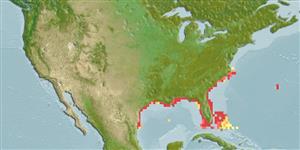>
Ophidiiformes (Cusk eels) >
Dinematichthyidae (Viviparous brotula)
Etymology: Gunterichthys: Because of Albert C. L. G. Günther, German ichthyologist, 1830-1914 (Ref. 45335).
Eponymy: Dr Gordon Gunter (1909–1998) was a marine biologist. [...] (Ref. 128868), visit book page.
Environment: milieu / climate zone / depth range / distribution range
Ecologia
marinhas; estuarina demersal; intervalo de profundidade 0 - 9 m (Ref. 34024). Subtropical; - 24°N
Western Atlantic: northern Gulf of Mexico.
Tamanho / Peso / Idade
Maturity: Lm ? range ? - ? cm
Max length : 7.5 cm TL macho/indeterminado; (Ref. 7251)
Descrição suscinta
Chaves de identificação | Morfologia | Morfometria
Raios dorsais (total) : 60 - 71; Raios anais : 41 - 52; Vértebras: 38 - 40. Diagnosis: Blunt snout; small distinct eyes, 1.4-1.9% SL in adults; head naked, body covered with imbricate scales; interorbital in adults 5.6-7.7% SL; posterior infraorbital pores 2; rays in dorsal fin 60-71, anal 41-52, caudal 12-15; otolith with fused colliculi; sulcus small; 1 pair of pseudoclaspers with 2 almost equally long supporters (Ref. 55786).
Burrows in soft mud bottoms at shallow depths (0.7-6 m) of quiet lagoons, backwaters and saline parts of estuaries (Ref. 7251, 55786). Reported to give birth to very few, about 15 mm long juveniles in each clutch; one female found to have four 5-8 mm long embryos and has a 3.2 mm bivalve in the intestine (Ref. 55786). Probably common where it occurs (Ref. 34024).
Ciclo de vida ou comportamento de acasalamento
Maturidade | Reprodução | Desova | Ovos | Fecundidade | Larvas
Nielsen, J.G., D.M. Cohen, D.F. Markle and C.R. Robins, 1999. Ophidiiform fishes of the world (Order Ophidiiformes). An annotated and illustrated catalogue of pearlfishes, cusk-eels, brotulas and other ophidiiform fishes known to date. FAO Fish. Synop. 125(18):178p. Rome: FAO. (Ref. 34024)
Status na Lista Vermelha da UICN (Ref. 130435: Version 2024-1)
Ameaça para os humanos
Harmless
Uso pelos humanos
Pescarias: sem interesse
Ferramentas
Relatórios especiais
Baixar XML
Fontes da internet
Estimates based on models
Preferred temperature (Ref.
123201): 23.3 - 26.8, mean 24.6 °C (based on 124 cells).
Índice de diversidade filogenética (Ref.
82804): PD
50 = 0.6250 [Uniqueness, from 0.5 = low to 2.0 = high].
Bayesian length-weight: a=0.00389 (0.00180 - 0.00842), b=3.12 (2.94 - 3.30), in cm total length, based on all LWR estimates for this body shape (Ref.
93245).
Nível Trófico (Ref.
69278): 3.3 ±0.5 se; based on size and trophs of closest relatives
Resiliência (Ref.
120179): Baixo, tempo mínimo de duplicação da população 4,5 - 14 anos (Assuming Fec < 100).
Fishing Vulnerability (Ref.
59153): Low vulnerability (10 of 100).
